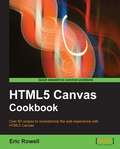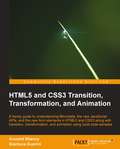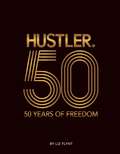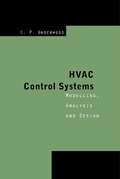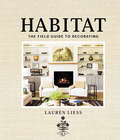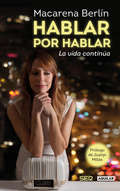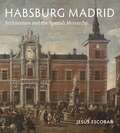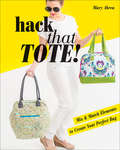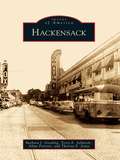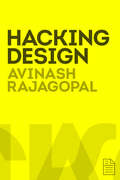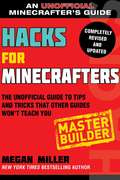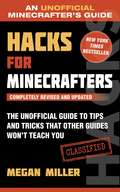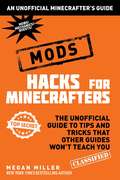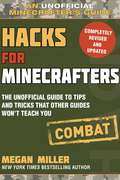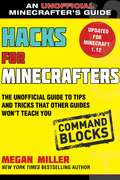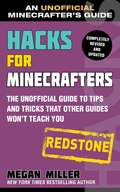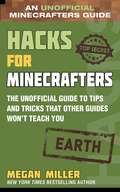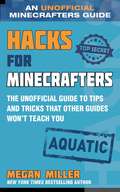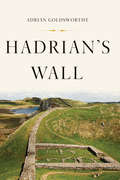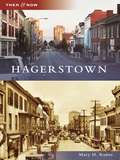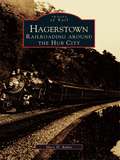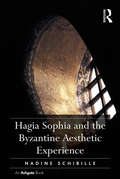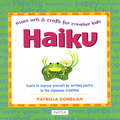- Table View
- List View
HTML5 Canvas Cookbook
by Eric RowellWritten in cookbook style, this book offers a wide array of techniques for building HTML5 Canvas applications. Each recipe contains step-by-step instructions followed by analysis of what was done in each task and other useful information. The book is designed so that you can read it chapter by chapter, or you can look at the list of recipes and refer to them in no particular order. This book is geared towards web developers who are familiar with HTML and JavaScript. It is written for both beginners and seasoned HTML5 developers with a good working knowledge of JavaScript.
HTML5 and CSS3 Transition, Transformation, and Animation
by Aravind Shenoy Gianluca GuariniQuick and simple example-driven introduction to HTML5 Transitions, Transformations and Animations. Learn by doing to create some simply amazing HTML5 web applications. If you are a web developer or designer and would love to learn and use the game changing technologies included within HTML5 this is the right book for you, start at the beginning and learn some of this technologies awesome features around transitions, transformations and animations. This book is for beginners with transitions, transformations and animations that want a quick and simple kick start using clear and reusable examples.
HUSTLER®: 50 Years of Freedom
by Flynt PublicationsFor 50 years, HUSTLER Magazine has been a cultural force—provocative, unconventional, and always pushing the conversation forward. HUSTLER®50: 50 Years of Freedom is a visually stunning coffee table book that takes readers through the magazine&’s rich history, showcasing its most talked-about moments, groundbreaking photography, and unwavering commitment to free speech.Founded in 1974 by Larry Flynt, HUSTLER redefined American self-expression, challenging societal norms and expanding the boundaries of mainstream media. From its early days as a small newsletter to its status as a media powerhouse, the magazine has left an undeniable mark on American culture. This book captures its journey through five decades of political and social upheaval—from the rebellious 1970s to the culture wars of the &’80s and &’90s, the digital revolution of the 2000s, and today&’s shifting landscape of gender and identity. Inside, readers will revisit some of HUSTLER&’s most controversial and influential moments, including the infamous 1975 Jackie O issue and the landmark Supreme Court battle with Jerry Falwell in 1983. The book showcases unforgettable covers—like the notorious &“Meat Grinder&” cover of 1978—that sparked conversations and cemented the magazine&’s place in pop culture. Beyond the photography, it features thought-provoking pieces by writers such as Charles Bukowski and Timothy Leary, proving that HUSTLER has always been about more than just pictures. Of course, no tribute to HUSTLER would be complete without celebrating the breathtaking women who have graced its pages. This book highlights the magazine&’s most iconic photo spreads—featuring stunning photography and some of the most beautiful women of each era—capturing the evolving aesthetics of the time period and the artistry behind the images. The legacy of Larry Flynt&’s Publisher Statements is also explored, revealing how his unfiltered critiques of political hypocrisy—through the Reagan years, the Clinton scandals, and beyond—made HUSTLER a unique platform for free speech and social commentary. The book also highlights how HUSTLER adapted to the digital age, embracing the Internet to reach new audiences while staying true to its roots. With an in-depth look at features like &“Beaver Hunt,&” which celebrated everyday women and redefined beauty standards, this book is both a tribute and a time capsule. HUSTLER®50 is a must-have for fans of the magazine, media historians, and anyone interested in how one publication challenged convention, redefined adult entertainment, and left an undeniable imprint on American culture
HVAC Control Systems: Modelling, Analysis and Design
by Chris P. UnderwoodThis important new book bridges the gap between works on classical control and process control, and those dealing with HVAC control at a more elementary level, which generally adopt a qualitative and descriptive control. Both advanced level students and specialist practitioners will welcome the in-depth analytical treatment of the subject presented in this volume. Of particular significance are the current developments in adaptive control, robust control, artificial neural networks and fuzzy logic systems, all of which are given a thorough analytical treatment in the book. First book to provide an analytical treatment of subject Covers all new developments in HVAC control systems Looks at systems both in the UK and abroad
Habitat: The Field Guide to Decorating
by Lauren Liess&“Stunningly simple, this field guide is a survival book for any budding decorator,&” by &“famed DC-based interior designer and blogger of Pure Style Home.&” (USA Today) Lauren Liess, an interior designer and founder of the popular blog Pure Style Home, fuses her love of design and the great outdoors into all her work. In Habitat: The Field Guide to Decorating, Lauren invites readers to bring nature inside by mixing the textures of natural elements such as wood and stone with eclectic groupings of modern and quirky vintage pieces. Readers will be inspired by the unique style of these rooms, which include lovely framed botanical prints and Liess&’s own textile patterns inspired by wildflowers and weeds. Divided into three sections, Habitat shows readers the fundamental elements of design, such as color, lighting, and furniture; addresses the intangibles of designing a space, such as aesthetics and creating a mood; and tackles unique room-specific challenges in every part of the house. &“Designer Lauren Liess shares her favorite, not-always-conventional ideas for livening up any space with art.&” ―Country Living &“Habitat looks at incorporating natural textures such as wood into your decorating scheme, along with florals, nature inspired textiles and vintage décor.&” ―Real Style Network &“Rich with thoughtful advice on how to create livable, comfortable rooms that bring the beauty of the outdoors inside.&” ―Garden & Gun
Hablar por hablar. La vida continúa
by Macarena BerlínHistorias de superación, de lucha... Historias de madrugada. «En este libro, el tercero que se escribe sobre el programa de radio Hablar por hablar, he recogido algunas de las llamadas que he atendido en los primeros cinco años que llevo al frente del mismo. Historias que quizá no hayan ocupado las primeras páginas de los periódicos, pero que han ilustrado las madrugadas de este programa social al servicio del oyente de la radio. Llamadas que bien pudo recibir Gemma Nierga, porque en algunos aspectos poco hemos cambiado; y llamadas que hace dos décadas eran impensables. Imaginación para ponerles voz a los personajes de la vida y empatía para sentir cada una de sus palabras es lo único que se necesita para acercarse al corazón de los protagonistas de Hablar por hablar».Macarena Berlín Macarena Berlín, directora y presentadora de Hablar por hablar en la Cadena SER, ofrece a los lectores las vocesde los protagonistas de este espacio radiofónico transcritas desde el corazón, desde la pura emoción. Historias de superación, de valentía, experiencias diversas que se van hilvanando con el objetivo de encontrar la comprensión al otro lado del teléfono, las palabras de aliento, de apoyo o el simple desahogo. Una obra emotiva repleta de realidad que atraviesa el alma y revela lo mejor de uno mismo. Hablar por Hablar es el espacio de radio hecho por y para los oyentes, que se emite en la Cadena SER. Lleva casi veinticinco años en antena y se ha convertido en un clásico de las madrugadas, con la audiencia más alta de la radio, en su franja horaria. Cada noche la realidad más cercana recupera sus derechos y los oyentes llaman a nuestro teléfono para compartir sus historias, sus inquietudes... de una forma natural y distendida, planteando debates y cuestionando todos los aspectos de la vida: desde los más cotidianos hasta los más insólitos, tocando la actualidad, pasando de lo entrañable a lo increíble, de lo más divertido a lo más triste. Reseña:«Este libro insólito es, entre otras cosas, el certificado de que lo que escucharon sucedió. Pero también de que lo soñaron. Es el certificado de que soñamos lo que nos sucede, o al revés, y de que la noche es una dimensión paralela de la que solo tomamos conciencia cuando se nos aparece, como en un eclipse, en medio del día. Este libro es un grumo de oscuridad en medio de la luz, pero también un fogonazo en medio de las tinieblas. Este libro es el revés de la vida. Al leerlo, se convierte en su derecho».Juanjo Millás
Habsburg Madrid: Architecture and the Spanish Monarchy
by Jesús EscobarWith its selection as the court of the Spanish Habsburgs, Madrid became the de facto capital of a global empire, a place from which momentous decisions were made whose implications were felt in all corners of a vast domain. By the seventeenth century, however, political theory produced in the Monarquía Hispánica dealt primarily with the concept of decline. In this book, Jesús Escobar argues that the buildings of Madrid tell a different story about the final years of the Habsburg dynasty.Madrid took on a grander public face over the course of the seventeenth century, creating a "court space" for residents and visitors alike. Drawing from the representation of the city’s architecture in prints, books, and paintings, as well as re-created plans standing in for lost documents, Escobar demonstrates how, through shared forms and building materials, the architecture of Madrid embodied the monarchy and promoted its chief political ideals of justice and good government. Habsburg Madrid explores palaces, public plazas, a town hall, a courthouse, and a prison, narrating the lived experience of architecture in a city where a wide roster of protagonists, from architects and builders to royal patrons, court bureaucrats, and private citizens, helped shape a modern capital.Richly illustrated, highly original, and written by a leading scholar in the field, this volume disrupts the traditional narrative about seventeenth-century Spanish decadencia. It will be welcomed by specialists in Habsburg Spain and by historians of art, architecture, culture, economics, and politics.
Habsburg Madrid: Architecture and the Spanish Monarchy
by Jesús EscobarWith its selection as the court of the Spanish Habsburgs, Madrid became the de facto capital of a global empire, a place from which momentous decisions were made whose implications were felt in all corners of a vast domain. By the seventeenth century, however, political theory produced in the Monarquía Hispánica dealt primarily with the concept of decline. In this book, Jesús Escobar argues that the buildings of Madrid tell a different story about the final years of the Habsburg dynasty.Madrid took on a grander public face over the course of the seventeenth century, creating a “court space” for residents and visitors alike. Drawing from the representation of the city’s architecture in prints, books, and paintings, as well as re-created plans standing in for lost documents, Escobar demonstrates how, through shared forms and building materials, the architecture of Madrid embodied the monarchy and promoted its chief political ideals of justice and good government. Habsburg Madrid explores palaces, public plazas, a town hall, a courthouse, and a prison, narrating the lived experience of architecture in a city where a wide roster of protagonists, from architects and builders to royal patrons, court bureaucrats, and private citizens, helped shape a modern capital.Richly illustrated, highly original, and written by a leading scholar in the field, this volume disrupts the traditional narrative about seventeenth-century Spanish decadencia. It will be welcomed by specialists in Habsburg Spain and by historians of art, architecture, culture, economics, and politics.
Hack That Tote!: Mix & Match Elements to Create Your Perfect Bag
by Mary Abreu“A terrific book for the beginner bag maker and anyone looking for fairly quick and easy bag projects” —from a wine-bottle bag to a zip-top purse (Homespun).One pattern . . . infinite looks! With simple tweaks, you can reinvent the basic tote 11 ways, sewing useful projects like a backpack, messenger bag, laundry duffle, and stylish cross-body purse. Create your perfect carryall by adding pockets, leather handles, fabric straps and tabs, O-rings, snap hooks, purse frames, and more for endless variety. A fabric and interfacing guide helps beginners and more experienced sewists choose the right materials every time. Just measure, mark, and cut—no printed patterns needed!Alter a basic tote 11 ways! Switch up the size, shape, pockets, straps, drawstrings, zippers, and hardware to create bags for many usesExpert tips on choosing the right fabric and interfacing for sturdy bags that look amazingEasy, dimensional cutting instructions for fast, professional results“In this beginner-friendly guide, Abreu (Modern Style for Girls) takes a basic square tote pattern and adjusts it in a variety of ways to create a wardrobe of attractive bags in different shapes and styles, from casual and functional to structured and sophisticated.” —Library Journal“Join Abreu as she takes a basic tote bag pattern and transforms it 11 different ways by varying the shape and size of her bags, as well as the detailing such as pockets, handles, and, of course, color and fabric combinations. By following Mary’s tips, you'll create professional-looking bags for yourself and friends.” —Quilter’s Companion
Hackensack
by Allan Petretti Theresa E. Jones Barbara J. Gooding Terry E. SellaroleHackensack rose from humble beginnings as a pre-Colonial meeting place for the Achkenheshacky people, members of the Lenni-Lenape tribe. In 1614, Dutch fur traders were the first Europeans to come to the area. Ancient footpaths served the new settlers well, and some of these paths became roads that are still in use today. The most quintessentially American of these roads, Main Street, terminates at a place known as "the Green," which provided a place to rest for a weary George Washington and his troops in 1776. It is also the site of the oldest church in Bergen County. Once a lure for New Yorkers seeking recreational outlets, Hackensack attracted many new permanent residents during the mid- to late 1800s. As the hub of Bergen County, the city led the way as the area moved away from its agrarian roots to a more industrialized society. In more recent times, Hackensack has been the birthplace of one of the seven original astronauts, home to the practice ice for three gold-medal-winning Olympic figure skaters, and a favorite lyric for singers and songwriters such as Billy Joel, Jimi Hendrix, Fountains of Wayne, and Johnny Cash.
Hacking Design
by Avinash RajagopalWhat if you could press a button and have a machine build you any product you wanted? What if we all had the means to modify our physical environment, to tweak and subvert objects produced for us by designers and manufacturers? A new generation of hardware hackers is making steady progress toward making these hypotheses reality, building vibrant communities in the process. And designers are experimenting with open-source creation and customization, trying to come to terms with the hackers' visions of the future. Hacking Design examines the conflicts and commonalities between hackers and professional designers, and uncovers shared ground on which the two creative communities can work together.DesignFile is the new line of e-books on topics and trends in design published by the Cooper-Hewitt, Smithsonian Design Museum. There will be six to twelve titles published annually, each ranging in length from 7,500 to 20,000 words. Building a consortium with institutional partners and design practitioners, Cooper-Hewitt's series will bridge the academic, museum, design, and publishing worlds. Inaugural members of the e-book consortium are Parsons The New School for Design and the School of Visual Arts.
Hacks for Minecrafters: Master Builder (Unofficial Minecrafters Hacks)
by Megan MillerFrom the New York Times bestselling author of Hacks for Minecrafters comes the most encompassing guide ever to the many amazing builds you can create in Minecraft. Now in paperback for the first time and completely revised and updated! With more than 100 million registered players, Minecraft has taken control of gamers all over the world. With Hacks for Minecrafters: Master Builder, you'll be able to take back that control! Now you can craft your world exactly how you want it to look, all while discovering the hidden gems of the game. Now being released in paperback, Hacks for Minecrafters: Master Builder has been updated for Minecraft 1.12, the World of Color update that added new function and crafting systems, illusioners, parrots, and building materials like glazed terracotta and concrete. In Hacks for Minecrafters: Master Builder, readers will learn how to build the coolest stuff, including an underwater house, a pirate ship, and a fortified castle! Other tips will help gamers:Find the best locationsChoose their favorite styleLearn how to get started with foundations and wallsBecome landscaping expertsLearn how to decorate their living roomAnd much more!Packed with expert tips, cheats, and hacks on planning all types of buildings and with more than one hundred screenshots, Hacks for Minecrafters: Master Builder shows exactly how the experts bring their amazing structures to life, from designing realistic roofs and exteriors to planning crenellated castle battlements. Detailed step-by-step illustrated guides will let every kid follow along to build their very own awesome castles, bridges, and farms and add the decor and landscaping details that bring their creations to life.
Hacks for Minecrafters: The Unofficial Guide to Tips and Tricks That Other Guides Won't Teach You (Hacks For Minecrafters #1)
by Megan MillerWith more than 100 million registered players, Minecraft has taken control of gamers all over the world. With Hacks for Minecrafters, you'll be able to take back that control! Only with the help found in Hacks for Minecrafters will you be able to craft your world exactly how you want it to look, all while discovering the hidden gems of the game. <p><p> Now being released in paperback, Hacks for Minecrafters has been updated for Minecraft 1.12, the World of Color update that added new function and crafting systems, illusioners, parrots, and building materials like glazed terracotta and concrete. <p> It doesn’t matter if you’re playing on a PC, mobile device, or home console; with Hacks for Minecrafters, you’ll be beating the game in no time. Every block has been accounted for, all living entities have been taken into consideration, and all modes of game-play are covered!
Hacks for Minecrafters: The Unofficial Guide to Tips and Tricks That Other Guides Won't Teach You (Hacks For Minecrafters #1)
by Megan MillerMinecraft was originally designed to let other people modify it. Unlike the other successful gaming guides already on the market, this one is the first unofficial “hacker’s” guide specifically for adding mods (modifications) to your Minecraft game. Its hacks for Minecrafters are designed for players ages 7-12, but Minecrafters of every age will enjoy it and find it useful. This adventuring series is ideal for fans of the classic good vs. evil fight, magical schools like Hogwarts, and games like Pokemon GO, Minecraft, and Terraria. <p><p> With adding mods, Minecrafters can make their own adventures within Minecraft. Mods add content to the game that can change gameplay. This gives the players more options for how they play in the world of Minecraft. This Minecraft mods book can guide readers to adding new mechanics, mobs, and quests to their games as well as entirely new dimensions to play in. The rules of your gaming world can be changed with each and every mod you add! <p> This book is a great gift for any Minecraft lover in your life. It is one of several Megan Miller Minecraft books. Anyone interested in Minecraft mods will use this hacks for Minecrafters book.
Hacks for Minecrafters: The Unofficial Guide to Tips and Tricks That Other Guides Won't Teach You (Hacks For Minecrafters Ser. #2)
by Megan MillerFrom the bestselling author of Hacks for Minecrafters and Hacks for Minecrafters: Master Builder comes the most encompassing guide ever to combat in the world of Minecraft. Now in paperback for the first time and completely revised and updated! <P><P>With more than 100 million registered Minecraft accounts and rights picked up by Warner Brothers for an action-adventure film in the style of The Lego Movie, Minecraft is one of the world's biggest children's brands. While there are several successful game guides on the market already, Hacks for Minecrafters: Combat Edition is the first unofficial "hacker's" guide dedicated to combat and geared toward seven- to twelve-year-old Minecrafters. Now being released in paperback, Hacks for Minecrafters: Combat Edition has been updated for Minecraft 1.12, the World of Color update that added new function and crafting systems, illusioners, parrots, and building materials like glazed terracotta and concrete. <P><P>In Hacks for Minecrafters: Combat Edition, readers will learn how to defend their property and fight off hostile mobs and monsters like zombies, spiders, and skeletons! Other tips include: Updated enchanting for armor, weapons, and more <br>How to deal with new behaviors for hostile mobs <br>The best ways to defeat new hostile mobs, such as killer bunnies, ocean-dwelling guardians, elder guardian mini-bosses, and the rare endermite <br>And much more!Packed with expert tips, cheats, and hacks on fighting all types of enemies and with more than one hundred screenshots, <P><P>Hacks for Minecrafters: Combat Edition shows exactly how the experts defend themselves and fight attackers, from cave spiders to creepers to zombie pigmen. In Minecraft, the risk of attack is ever-present, and players need to know how to build weapons, set traps, and escape to safety.
Hacks for Minecrafters: The Unofficial Guide to Tips and Tricks That Other Guides Won't Teach You (Hacks For Minecrafters Ser. #3)
by Megan MillerFrom the author of Hacks for Minecrafters comes the updated 1.13 guide to using command blocks in the world of Minecraft! If you want to be the best at Minecraft, you’ve got to read up on the latest tricks. This book is packed with full-color screenshots showing the newest, coolest ways to use one of Minecraft’s coolest features. With Hacks for Minecrafters: Command Blocks, kids will learn everything they need to know about manipulating and programming command blocks within Minecraft. As well as clearly explaining the commands and how to use them, this book has tons of fun tricks and projects for making your own custom maps and mini-games. Other tips cover: Giving and getting loot Putting any enchantment on a weapon Customizing villagers Supercharging mobs with data tags Creating a massive fireworks display Combining command blocks to make programs Packed with expert tips, cheats, and hacks on command blocks, including a reference to commands, and block, item, and entity IDs, and exactly how you use them, and with over one hundred screenshots, Hacks for Minecrafters: Command Blocks shows exactly how the experts wield command blocks and make fun modifications to the Minecraft world.
Hacks for Minecrafters: The Unofficial Guide to Tips and Tricks That Other Guides Won't Teach You (Hacks For Minecrafters Ser. #5)
by Megan MillerFrom the author of Hacks for Minecrafters comes the updated 1.9 guide to using redstone in the world of Minecraft! If you want to be the best at Minecraft, you’ve got to read up on the latest tricks. This book is packed with full-color screenshots showing the newest, coolest ways to use Minecraft’s most precious resource. With Hacks for Minecrafters: Redstone, kids will learn the basics of manipulating redstone to make amazing contraptions. Readers young and old will love the clear and illustrated explanations of redstone power and current, as well as instructions on building essential redstone logic gates, loops, and circuits. Hacks for Minecrafters: Redstone will also demonstrate exactly how to construct some classic and crazy contraptions and machines, including: Automatic doors and furnacesHidden traps and staircasesTNT cannonAutomatic wheat or sugar-cane farmMob piston grinderAnd much more! Packed with expert tips, cheats, and hacks on redstone and with over one hundred screenshots, Hacks for Minecrafters: Redstone shows exactly how the experts wield redstone power and build amazing contraptions. In Minecraft, the risk of attack is ever-present, and players need to utilize every resource available to them, especially redstone.
Hacks for Minecrafters: The Unofficial Guide to Tips and Tricks That Other Guides Won't Teach You (Hacks for Minecrafters #1)
by Megan MillerHacks for the fully mobile, real-world gaming experience by New York Times bestselling author Megan Miller. With Hacks for Minecrafters: Earth, you'll know everything you need to know to harness the world of cutting-edge, augmented-reality world of Minecraft Earth on your phone or tablet. This is the illustrated guide you need to create the best structures, embark on the most exciting virtual adventures with friends, and unlock the most exclusive resources and mobs available. In this hacker's guide, you'll find inside tips on: Tappables—Collecting the best build materials and mobs in your area!Crafting—Managing, smelting and using your resources to craft like a pro!Buildplates—Placing them, using tabletop and life-size mode, inviting friends to build with you, and more!Adventures—Mining, battling, and discovering exciting worlds with friends! You will never be stuck again. With more than one hundred full-color screenshots of in-game footage, you&’ll be able to carefully follow every tip with precision. With Hacks for Minecrafters: Minecraft Earth, you&’ll have all the inside information you need to call yourself a pro Minecraft Earth gamer.
Hacks for Minecrafters: The Unofficial Guide to Tips and Tricks That Other Guides Won't Teach You (Hacks for Minecrafters #1)
by Megan MillerA brand-new hacks guide by New York Times bestselling author Megan Miller for the epic underwater world! With more than 100 million registered players, Minecraft has captured the imagination of gamers all over the world. With Hacks for Minecrafters: Aquatic, you'll be able to discover the hidden gems of its new and improved underwater world. Only with the help found in this comprehensive, kid-friendly guide will you be able to craft, mine, explore, survive, and thrive in the watery depths of your favorite sandbox game. In this hacker's guide, you'll find expertise on: Mining—find buried treasure and rare gems like the Heart of the Sea!Battle—Learn how to attack and conquer the massive underwater Ocean Monument and defeat the hostile Elder Guardians that protect itCraft—use your underwater resources to craft tridents and build conduits!Discover—explore shipwrecks, coral reefs, and swim with dolphins! You will never be stuck again! With more than one hundred full-color screenshots of in-game footage, you&’ll be able to carefully follow every tip with precision. It doesn&’t matter if you&’re playing on a PC, mobile device, or home console; with Hacks for Minecrafters: Aquatic, you&’ll master this update in no time. Every block has been accounted for, all living entities have been taken into consideration, and all modes of game-play are covered!
Hacks for TikTok: 150 Tips and Tricks for Editing and Posting Videos, Getting Likes, Keeping Your Fans Happy, and Making Money
by Kyle BrachBecome a Pro at TikTok with This Tell-All Guide! From getting started to getting famous, Hacks for TikTok is the perfect hands-on guide for learning how to use Tiktok for your own personal enjoyment as well as for getting noticed, getting likes, and getting followed. This book covers the ins and outs of the app, providing practical advice so that you can master creating and managing content and grow your following. With this comprehensive guide, learn how to:• Navigate the TikTok app • Edit and post videos • Add special effects and sound clips • Interact and engage with your audience • Go viral and get famous • Keep your fans happy • Make money • And learn hacks for duets, skits, lip-syncing, challenges, and more! Including simple step-by-step instructions and screenshots for visual aid, this book is the perfect resource for beginners looking to learn the ropes and experts to brush up on their knowledge.
Hadrian's Wall: The Landmark Library (The\landmark Library #6)
by Adrian GoldsworthyFrom an award-winning historian of ancient Rome, a definitive history of Hadrian's WallStretching eighty miles from coast to coast across northern England, Hadrian's Wall is the largest Roman artifact known today. It is commonly viewed as a defiant barrier, the end of the empire, a place where civilization stopped and barbarism began. In fact, the massive structure remains shrouded in mystery. Was the wall intended to keep out the Picts, who inhabited the North? Or was it merely a symbol of Roman power and wealth? What was life like for soldiers stationed along its expanse? How was the extraordinary structure built--with what technology, skills, and materials?In Hadrian's Wall, Adrian Goldsworthy embarks on a historical and archaeological investigation, sifting fact from legend while simultaneously situating the wall in the wider scene of Roman Britain. The result is a concise and enthralling history of a great architectural marvel of the ancient world.
Hagerstown
by Mary H. RubinLying just north of the Potomac River in the heart of the fertile Cumberland Valley, Hagerstown, Maryland has been at the crossroads of history and commerce since its founding in 1762. Nestled between the Blue Ridge and Allegheny Mountains, the city sits on a north-south path that migration, war, and commerce have traveled for centuries, while the nearby Potomac River carves out a natural path that served as a gateway to the American West. This fortunate geography influenced the growth and development of Hagerstown, the seat of Washington County, and also earned it the nickname "Hub City." The unique story of Hagerstown, captured in this volume of vintage photographs, includes not only the tales of the Civil War, the coming of the railroad, and the C&O Canal, but of the men and women who built a community and made it home. Through their perseverance and spirit, the city took shape--businesses were established, schools, hospitals, and churches erected, and neighborhoods formed. From Alsatia Mummer's parades and the Great Hagerstown Fair to the bygone days when trolleys rolled through town, the heritage of this singular city is recalled and honored in this engaging tribute.
Hagerstown: Railroading Around the Hub City
by Mary H. RubinHagerstown, Maryland's history is inextricably linked to the railroad. Hagerstown's nickname of the "Hub City" comes from the wheel-spoke effect that the many rail lines in and out of the city created. The first train cars from the Baltimore & Ohio Railroad reached the limits of Washington County on December 3, 1834, where the line crossed into Harper's Ferry, West Virginia. The railroad was instrumental in transporting both goods and passengers and helped spell the demise of the C & O Canal. Through the years, the railroads continued to ply the tracks through the county providing work for many, and transportation of freight and passenger service from Baltimore in the east to the great expanse of the country to the west. Today, passenger service no longer runs through Hagerstown, but freight service continues and trains are far from forgotten.
Hagia Sophia and the Byzantine Aesthetic Experience
by Nadine SchibilleParamount in the shaping of early Byzantine identity was the construction of the church of Hagia Sophia in Constantinople (532-537 CE). This book examines the edifice from the perspective of aesthetics to define the concept of beauty and the meaning of art in early Byzantium. Byzantine aesthetic thought is re-evaluated against late antique Neoplatonism and the writings of Pseudo-Dionysius that offer fundamental paradigms for the late antique attitude towards art and beauty. These metaphysical concepts of aesthetics are ultimately grounded in experiences of sensation and perception, and reflect the ways in which the world and reality were perceived and grasped, signifying the cultural identity of early Byzantium. There are different types of aesthetic data, those present in the aesthetic object and those found in aesthetic responses to the object. This study looks at the aesthetic data embodied in the sixth-century architectural structure and interior decoration of Hagia Sophia as well as in literary responses (ekphrasis) to the building. The purpose of the Byzantine ekphrasis was to convey by verbal means the same effects that the artefact itself would have caused. A literary analysis of these rhetorical descriptions recaptures the Byzantine perception and expectations, and at the same time reveals the cognitive processes triggered by the Great Church. The central aesthetic feature that emerges from sixth-century ekphraseis of Hagia Sophia is that of light. Light is described as the decisive element in the experience of the sacred space and light is simultaneously associated with the notion of wisdom. It is argued that the concepts of light and wisdom are interwoven programmatic elements that underlie the unique architecture and non-figurative decoration of Hagia Sophia. A similar concern for the phenomenon of light and its epistemological dimension is reflected in other contemporary monuments, testifying to the pervasiveness of these aesthetic values in early Byzantium.
Haiku
by Patricia DoneganHaiku introduces five styles of haiku to readers and includes projects on:* Your first haiku--how to get started with the classic form of poetry* Your favorite season--exploring nature, a traditional element in haiku* Your own personal haiku--writing in haibun, a form of haiku that uses personal narrative* Haiku with pictures--creating haiga, an illustrated haiku* Haiku with a friend--developing renga, linked-verse haikuThe Asian Arts & Crafts for Creative Kids series is the first series, aimed at readers ages 7-12, that provides a fun and educational introduction to Asian culture and art. Through hands on projects readers will explore each art--engaging in activities to gain a better understanding of each form.
